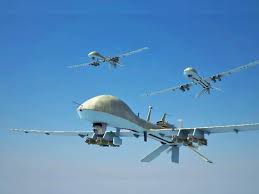The Hindu : Page 04
Syllabus : GS 2 & 3 : Governance & Internal Security

The Defence Acquisition Council, chaired by Defence Minister Rajnath Singh, approved amendments for procuring 31 MQ-9B UAVs from the U.S., focusing on indigenous content.
- The Council also approved proposals for an advanced navigation system for the Army and 22 Interceptor Boats for the Coast Guard, enhancing India’s defense capabilities.
About MQ-9B HALE UAV
- The MQ-9B drone is a version of the MQ-9 “Reaper” and has two models: Sky Guardian and Sea Guardian.
- It is built by the General Atomics.
- This drone can fly over 40,000 feet high, making it useful for watching the Himalayan border areas.
- It can stay in the air for up to 40 hours, perfect for long surveillance missions.
- The MQ-9B has advanced features like automatic take-off and landing, a system to avoid other objects, secure GPS, and encrypted communications.
- It can offer 80% of a manned aircraft’s capabilities at 20% of the cost per hour.

Deployment:
- The MQ-9B drones are planned to be deployed at four places, including INS Rajaji near Chennai and Porbandar in Gujarat, by the Indian Navy.
- The other two services will keep them jointly at two bases in Sarsawa and Gorakhpur in Uttar Pradesh at Air Force bases due to long runway requirements.
Specifications of the Procurement:
- India is looking to procure 31 MQ-9B UAVs, including 15 Sea Guardians for the Indian Navy and 16 Sky Guardians (eight each for the Indian Army and Air Force).
- The Indian Navy has leased two MQ-9As with the maiden flight taking place on November 21, 2020.
- The estimated cost is $3.99 billion.
- As part of the deal, General Atomics will establish a Global Maintenance, Repair, and Overhaul (MRO) facility in India, contributing to offset obligations.
- Significance of the deal
- The SeaGuardian model can help the Navy patrol large areas more economically than manned aircraft.
- For the Army and Air Force, these drones will help monitor movements along the borders, especially with China.
The Defence Acquisition Council (DAC)
- Establishment: Formed in 2001, under the Ministry of Defence, India.
- Objective: To ensure expeditious procurement of the approved requirements of the armed forces in terms of capabilities sought and time frame prescribed by optimally utilising the allocated budgetary resources.
- Chairperson: Chaired by the Defence Minister of India.
- Members: Includes the Chiefs of the Army, Navy, and Air Force, the Defence Secretary, and other senior officials from the Ministry of Defence.
- Functions: Approval of Procurement: Approves capital acquisitions for the defence forces.
- Policy Formulation: Recommends policies to streamline defence procurement.
- Monitoring: Monitors progress of major procurement projects.
- Importance: Plays a critical role in modernising and enhancing the operational capabilities of the Indian Armed Forces.
- Recent Initiatives: Emphasis on promoting ‘Make in India’ in defence production and increasing indigenous content in defence procurements.
UPSC Prelims PYQ : 2018
Ques : What is “Terminal High Altitude Area Defense (THAAD)”, sometimes seen in the news?
(a) An Israeli radar system
(b) India’s indigenous anti-missile programme
(c) An American anti-missile system
(d) A defence collaboration between Japan and South Korea
Ans : c)


